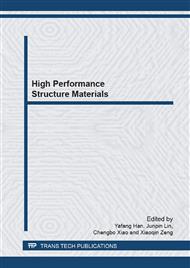[1]
J.X. Li, H.B. Zhang. Influence of deformation ratio, heat treatment system on as-cast microstructure of weld area, grain size and mechanical properties of GH536 welded tube, Journal of Iron and Steel Research. 15 (7) (2003) 433-437.
Google Scholar
[2]
W.H. Wei, S. Yang, E.P. Chen, D.S. Dong, Study on the hot workability of GH536 superalloy, Iron and Steel. 29 (1) (1994) 47-51.
Google Scholar
[3]
M. Zhao, L.Y. Xu, K.S. Zhang, et al., Study on high-temperature low cycle fatigue behavior of nickel base superalloy GH536, Mechanical Science and Technology. 21 (2) (2002) 279-281.
Google Scholar
[4]
S.S. Zhao, H.J. Xu, M. Xie, Y. Zhao, Studies of mechanical properties and microstructures of argon-shielded arc welding joint of GH536 superalloy, Journal of Dalian Jiaotong University. 31 (5) (2010) 47-49.
Google Scholar
[5]
K. Wang, Nickel base superalloy GH536 low temperature plastic non equilibrium segregation mechanism theory and experimental research, Central Iron and Steel Research Institute, doctoral dissertation. (2009) 52-91.
Google Scholar
[6]
T. Sakthivel, K. Laha, M. Nandagopal, et al., Effect of temperature and strain rate on serrated flow behavior of Hastelloy X, Mater. Sci. Eng. A. 534 (2012) 580-587.
DOI: 10.1016/j.msea.2011.12.011
Google Scholar
[7]
Sudarshan Rao G, Sharma VMJ, Thomas Tharian K. Study of LCF behavior of In 718 superalloy at room temperature, Mater. Sci. For. 710 (2012) 445-450.
DOI: 10.4028/www.scientific.net/msf.710.445
Google Scholar
[8]
C.H. Peng, H. Chang, R. Hu, J.K. Fan, et al., Static recrystallization kinetics of Haynes230 superalloy, Journal of Aeronautical Materials. 31 (2) (2011) 8-11.
Google Scholar
[9]
G.L. Xu, Y.P. Wang, H.J. Yan, The effects of cold deformation on microstructure of steel Ti + P – IF, Anshan Iron and Steel Technology. 3 (2009) 33-38.
Google Scholar
[10]
Y.Q. Bao, Metal Science Foundation, Metallurgical Industry Press, Beijing, 1986, pp.328-334.
Google Scholar
[11]
Juan Pablo Fetter, Tommy De Cock, Carlos Capdevila, Comparison of the annealing behaviour between cold and warm rolled ELC steel by thermoelectric power measurements, Acta Materialia. 55 (6) (2007) 2075-(2083).
DOI: 10.1016/j.actamat.2006.11.010
Google Scholar
[12]
G. Erdem, Y. Taptik, Effect of hot rolling conditions to produce deep drawing quality steels for continuous annealing process, Journal of Materials Processing Technology. 170 (1-2) (2005) 17-23.
DOI: 10.1016/j.jmatprotec.2005.04.097
Google Scholar
[13]
W.M. Mao, P. Yang, Cold material texture analysis principle and detection technology, Metallurgical Industry Press, Beijing, 2008, pp.28-37.
Google Scholar
[14]
Q.W. Jiang, C.S. He, Y.D. Liu, Cold rolling reduction on IF steel fiber texture evolution of quantitative study, Journal of Materials and Metallurgy. 2 (2) (2003) 137-141.
Google Scholar
[15]
Y.F. Gu, D.L. Lin, J.G. Chen, The directionally solidified Ni3Al alloy after high temperature deformation microstructure, Acta metallurgica Sinica. 34 (4) (1998) 351-355.
Google Scholar
[16]
W.M. Mao, Metal materials with the different crystallographic textures, Science Press, Beijing, 2002, pp.118-125.
Google Scholar


